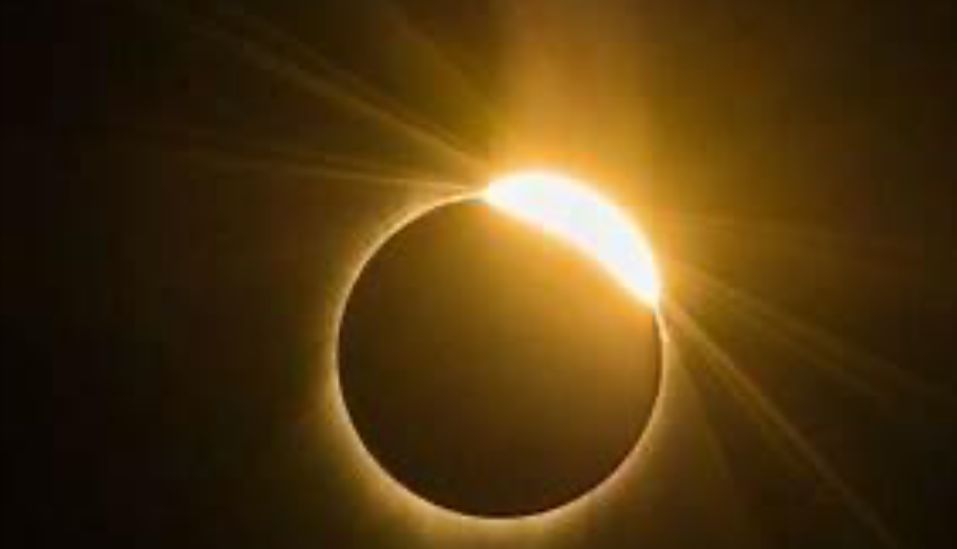Trending
United States and Mexico currently experiencing Total solar eclipse as it builds up in the two Countries.

On Monday, April 8, 2024, a total solar eclipse will cross North America, passing over Mexico, the United States, and Canada, the National Aeronautics and Space Administration has revealed.
A total solar eclipse happens when the moon passes between the sun and earth, completely blocking the face of the sun. The sky will darken as if it were dawn or dusk.
While disclosing the information on Sunday, NASA said, “Safety is the number one priority when viewing a total solar eclipse. Be sure you’re familiar with when you need to wear specialised eye protection designed for solar viewing by reviewing these safety guidelines.”
The agency said people could watch live with them as the total solar eclipse “moves across North America on April 8, 2024, traveling through Mexico, across the United States from Texas to Maine, and out across Canada’s Atlantic coast.”
Except during the brief total phase of a total solar eclipse, when the moon completely blocks the sun’s bright face, it is not safe to look directly at the sun without specialised eye protection for solar viewing, it says on safety.
Viewing any part of the bright sun through a camera lens, binoculars, or a telescope without a special-purpose solar filter secured over the front of the optics will instantly cause severe eye injury, it further warns.
“When watching the partial phases of the solar eclipse directly with your eyes, which happens before and after totality, you must look through safe solar viewing glasses (‘eclipse glasses’) or a safe handheld solar viewer at all times. You can also use an indirect viewing method, such as a pinhole projector,” NASA added.
The agency noted that the solar eclipse would be different from the last one experienced in 2017.
In 2017, an estimated 215 million US adults (88% of US adults) viewed the solar eclipse, either directly or electronically. They experienced the moon pass in front of the Sun, blocking part or all of our closest star’s bright face. The eclipse in 2024 could be even more exciting due to differences in the path, timing, and scientific research, NASA revealed on its website.
Wider, more populated path
According to the agency, the path of totality – where viewers can see the moon totally block the sun, revealing the star’s outer atmosphere, called the corona – is much wider during the upcoming total solar eclipse than it was during the eclipse in 2017.
As the moon orbits earth, its distance from our planet varies, NASA said, noting that during the 2017 total solar eclipse, the moon was a little bit farther away from earth than it would be during the upcoming total solar eclipse, causing the path of that eclipse to be a little skinnier. In 2017, the path ranged from about 62 to 71 miles wide. During the Monday eclipse, the path over North America will range between 108 and 122 miles wide – meaning at any given moment, this eclipse covers more ground.
The 2024 eclipse path will also pass over more cities and densely populated areas than the 2017 path did. This will make it easier for more people to see totality.
“An estimated 31.6 million people live in the path of totality this year, compared to 12 million in 2017. An additional 150 million people live within 200 miles of the path of totality,” the organisation disclosed.
Trending
One of the gunmen who opened fire on innocent civilians observing Hanukkah at Bondi Beach has been identified as Naveed Akram.

One of the gunmen who opened fire on innocent civilians observing Hanukkah at Bondi Beach has been identified as Naveed Akram.
On of the suspects was disarmed by a bystander and it’s been gathered that the police have arrested one of the suspects.
NB: This page does not support violence and this is just a news report for awareness.

Trending
During a Sunday Service Dr Chris OKAFOR have responded to Doris Ogala on why he didn’t marry her

Pastor Chris Okafor has addressed allegations made by actress Doris Ogala, who claimed he promised to marry her but is now engaged to another woman. During a Sunday service, Okafor reportedly said, “You are just being arrogant to people, taking to people anyhow, you say ‘I no dey respect anybody o, I no well’. Yet you’re a young lady you’re not married na you dey talk like that. Which man wan marry who no well? Which man wan marry you when they know you have slept with different men? God forbid!”.
Okafor’s response comes after Ogala shared her emotional story, alleging that she lost a pregnancy for him, and he made a video of it public. She also claimed he owes her N45 million and that their relationship has left her emotionally broken.
The drama has sparked intense debate online, with many calling for clarity and urging restraint. Ogala has vowed to disrupt Okafor’s wedding, insisting he cannot destroy her life and move on.
https://www.instagram.com/reel/DSPe0JLDX3B/?igsh=a2ZkczJ6azdkeDR0
Trending
Incredible moment hero bystander tackles Bondi Beach gunman and turns gun on him after mass shooting during Jewish party in Australia

A dramatic video has captured the moment a brave bystander disarmed one of the gunmen involved in the deadly Bondi Beach shooting on Sunday, December 14, preventing further bloodshed as chaos unfolded along the crowded shoreline.
The footage shows a man wearing a white T-shirt calmly approaching an armed attacker from behind as the suspect raises his weapon. In a swift move, the bystander grabs the gun, and after a brief struggle, successfully pulls it away from the shooter.
As the assailant falls to the ground, the civilian briefly points the weapon in his direction but does not fire. The gunman then staggers away, while the bystander places the firearm against a nearby tree before stepping back. Moments later, the camera pans to a second gunman, who appears visibly shaken by the sudden turn of events.
The courageous intervention came amid a violent attack in which two gunmen opened fire on beachgoers during a crowded evening at Bondi Beach. Gunshots echoed across the area, triggering panic as hundreds of people fled the sand and surrounding streets.
Police later confirmed that at least 10 people, including one of the attackers, were k!lled in the shooting. The second suspect was taken into custody. Authorities also said at least 12 others were injured, among them two police officers who were shot during the incident.
Witnesses told local media that the attackers exited a vehicle on Campbell Parade near the Bondi Pavilion at about 6:40pm before opening fire. Emergency responders rushed to the scene, with dozens of ambulances and helicopter paramedics deployed to assist victims. Paramedics treated multiple casualties on site, while others were transported to nearby hospitals.
One mother described scenes of terror as panic broke out while her daughters were at the beach with friends. Videos circulating online show large crowds running for safety as gunfire rang out.
NB: This page does not support violence and this is just a news report.
https://www.instagram.com/reel/DSPY_vXjF-n/?igsh=MW43em1hcjE1dDJ0MA==
-
Business1 year ago
US court acquits Air Peace boss, slams Mayfield $4000 fine
-

 Trending1 year ago
Trending1 year agoNYA demands release of ‘abducted’ Imo chairman, preaches good governance
-

 Politics1 year ago
Politics1 year agoMexico’s new president causes concern just weeks before the US elections
-

 Politics1 year ago
Politics1 year agoPutin invites 20 world leaders
-

 Politics1 year ago
Politics1 year agoRussia bans imports of agro-products from Kazakhstan after refusal to join BRICS
-
Entertainment1 year ago
Bobrisky falls ill in police custody, rushed to hospital
-
Entertainment1 year ago
Bobrisky transferred from Immigration to FCID, spends night behind bars
-
Education1 year ago
GOVERNOR FUBARA APPOINTS COUNCIL MEMBERS FOR KEN SARO-WIWA POLYTECHNIC BORI













